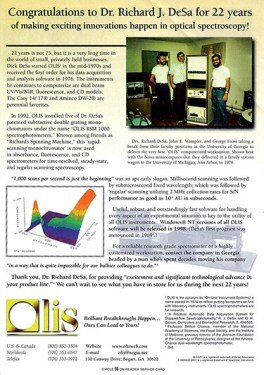Some Known Factual Statements About Spectrophotometers
Table of ContentsThe Facts About Uv/vis/nir RevealedSee This Report on Uv/visThe 6-Second Trick For SpectrophotometersThe Buzz on SpectrophotometersSome Known Incorrect Statements About Circularly Polarized Luminescence

Spectrophotometry is a tool that hinges on the quantitative analysis of molecules depending on how much light is absorbed by colored substances.
The Facts About Circularly Polarized Luminescence Uncovered
A spectrophotometer is typically used for the measurement of transmittance or reflectance of services, transparent or opaque solids, such as sleek glass, or gases. Many biochemicals are colored, as in, they soak up visible light and for that reason can be measured by colorimetric procedures, even colorless biochemicals can typically be converted to colored substances appropriate for chromogenic color-forming responses to yield compounds suitable for colorimetric analysis.: 65 However, they can likewise be created to measure the diffusivity on any of the listed light varieties that typically cover around 2002500 nm using different controls and calibrations.
An example of an experiment in which spectrophotometry is utilized is the decision of the balance constant of an option. A particular chain reaction within a solution might occur in a forward and reverse instructions, where reactants form products and items break down into reactants. At some time, this chain reaction will reach a point of balance called an equilibrium point.
Facts About Circularly Polarized Luminescence Uncovered
The quantity of light that goes through the option is indicative of the concentration of certain chemicals that do not permit light to pass through. The absorption of light is because of the interaction of light with the electronic and vibrational modes of molecules. Each kind of molecule has a specific set of energy levels related to the makeup of its chemical bonds and nuclei and thus will take in light of specific wavelengths, or energies, leading to unique spectral properties.
Making use of spectrophotometers spans various scientific fields, such as physics, products science, chemistry, biochemistry. spectrophotometers, chemical engineering, and molecular biology. They are commonly used in numerous industries consisting of semiconductors, laser and optical manufacturing, printing and forensic examination, in addition to in laboratories for the research study of chemical compounds. Spectrophotometry is typically utilized in measurements of enzyme activities, determinations of protein concentrations, decisions of enzymatic kinetic constants, and measurements of ligand binding reactions.: anonymous 65 Ultimately, a spectrophotometer is able to identify, depending on the control or calibration, what substances are present in a target and exactly how much through estimations of observed wavelengths.
This would come as an option to the formerly created spectrophotometers which were unable to absorb the ultraviolet correctly.
Circular Dichroism Things To Know Before You Buy
It would be found that this did not offer acceptable results, therefore in Design B, there was a shift from a glass to a quartz prism which permitted much better absorbance results - circularly polarized luminescence (http://www.cartapacio.edu.ar/ojs/index.php/iyd/comment/view/1414/0/30215). From there, Design C was born with a change to the wavelength resolution which wound up having three units of it produced
It was produced from 1941 to 1976 where the cost for it in 1941 was US$723 (far-UV devices were a choice at additional expense). In the words of Nobel chemistry laureate Bruce Merrifield, it was "most likely the most essential instrument ever developed towards the development of bioscience." Once it became discontinued in 1976, Hewlett-Packard developed the very first commercially available diode-array spectrophotometer in 1979 referred to as the HP 8450A. It irradiates the sample with polychromatic light which the sample soaks up depending on its properties. It is sent back by grating the photodiode range which discovers the wavelength region of the spectrum. Ever since, the development and application of spectrophotometry devices has actually increased profoundly and has actually turned into one of the most innovative instruments of our time.

Circular Dichroism Fundamentals Explained
The grating can either be movable or repaired.
In such systems, the grating is fixed and the intensity of each wavelength of light is determined by a various detector in the selection. When making transmission measurements, the spectrophotometer quantitatively compares the portion of light that passes through a referral service and a test option, then digitally compares the intensities of the two signals and computes the portion of transmission of the sample compared to the reference standard.
